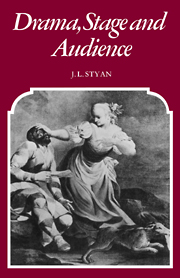5 - Acting and role-playing
Published online by Cambridge University Press: 02 December 2009
Summary
We are so accustomed to seeing actors impersonating ‘characters’ as realistically as possible, trying to the utmost of their bent to convince us of the living actuality of the figures they represent, that we forget that conviction of reality is only one, relatively minor, purpose the actor may pursue. Realism in characterization is so recent an objective for the actor that it does not seem unfair to see it as merely a period convention like any other; it is important, but only in so far as it belongs to our time. Realistic acting was a direct result of the naturalistic movement in the theatre after Ibsen, and of the continuing expectations of the film and television media long after the stage had dropped them. As a convention, it has already passed into history because of the greater needs of a succession of dramatic movements from symbolism, expressionism and the absurd, which called for abstract characterization, to the forms of epic theatre in Brecht and Genêt, who required the actor to play freely in and out of character. The actor's role is returning to its former function, which was not first that of impersonation, but nearer to that of interpreter and spokesman.
It is necessary to take the perspective view. The actor has the double advantage of being human like his spectators, looking like them, able to represent and demonstrate their feelings, and at the same time capable of impersonating the creatures of an unreal fiction, giving a kind of life to the figures of pure fantasy.
- Type
- Chapter
- Information
- Drama Stage and Audience , pp. 141 - 179Publisher: Cambridge University PressPrint publication year: 1975



